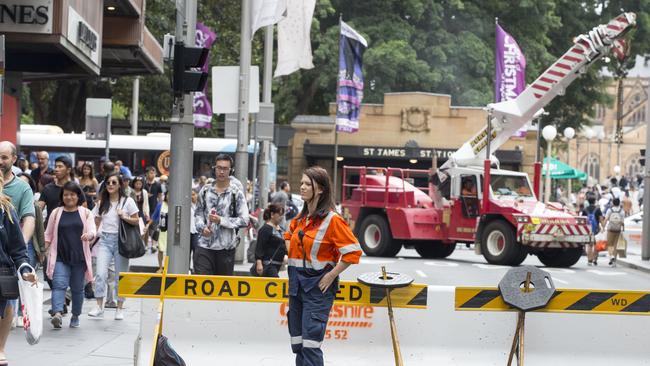Editorial: City bollards reminiscent of WWII security measures
AUTHORITIES are to be congratulated for their clever repurposing of trucks and cranes as security barricades, which were clearly appreciated by Sydney’s voracious Boxing Day shoppers.

Opinion
Don't miss out on the headlines from Opinion. Followed categories will be added to My News.
NOSTALGIC readers may enjoy searching YouTube for newsreels produced for several decades during the 20th century by the British Pathe News organisation.
Those newsreels, shown in cinemas back in the day, frequently featured Sydney street scenes. They depict a very different city to the one we find so familiar today. Crowds are smaller, obviously, and roadways noticeably less packed with traffic.
And there is something else missing, too. There are no concrete security bollards. Nor are there massive vehicles placed strategically around Sydney to prevent terrorist attacks.
Boxing Day shoppers were yesterday protected from terrorist attacks by four trucks, two cranes and more than 60 bollards forming a makeshift fortress. The combination of steel, cement and plastic effectively blocked off Market, George, Elizabeth and Castlereagh streets.
Sydney’s stores may have been well and truly open for business, but Sydney was definitely closed to anyone planning a vehicle-based attack on pedestrians. For their part, shoppers seemed comfortable with the strategically-placed protective structures.

“The trucks aren’t pretty but they do the job,” shopper Barbara Antonievich told The Daily Telegraph. “The bigger the crowd, the safer I feel.”
“I think what they’ve done with the bollards and road closures is safer and better but it is still a concern,” David Mason said. “I’m just trying to avoid mass clumps of people.”
Authorities are to be congratulated for their clever repurposing of trucks and cranes as security barricades, which were clearly appreciated by Sydney’s voracious Boxing Day shoppers.
But there was also a hint of regret that such measures should even be necessary in a city previously noted for its freedoms. Sydney has not known levels of security like this since World War II, when Japanese midget submarines attacked vessels in Sydney Harbour and rained shells on the eastern suburbs. During that era households would observe strict lights-out policies at night to frustrate potential air attacks.
Sydney has not quite returned to those days, but the mood among our people may be similar. There is also a powerful optimism that, just as in World War II, we will prevail.
